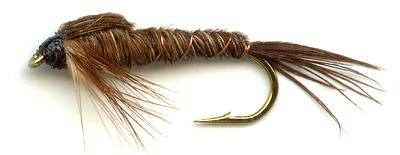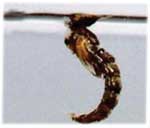The Hackled Pheasant Tail Nymph Fly
Hackled Pheasant Tail Nymph's streamlined shape penetrates the water surface instantly and sinks quickly. It is the fly pattern I use for fishing for trout on a sinking line when the fish are feeding at depth

PHEASANT TAIL FLY PATTERNS. Hook size 12 14 16 18 - $US each
PHEASANT TAIL NYMPH FLIES ON A SINKING LINE
On open water. I take delight in fishing floating line but sometimes the fish feeding a bit deeper and are refusing to come up the surface. Simply switching to a sinking line floating line rarely works unless you know what your doing. The two fishing techniques are totally different. Your success will grow once you understand the way fishing fly patterns behave behind a sinking line. For the novice, the lack of useful information you receive using a sinking line compared with the floating line can be quite irritating. What I'm talking about is that when retrieving flies just under the surface, you can obtain masses of visual information in the form of follows that may not result in touches, or takes. They help you planning the next cast and tactics. Very little of this type of visual data is available when fishing on a sunken line.
You may feel a bump on the retrieve to indicate that the fish was taking an interest in one of your flies, but it doesn't tell you which one. You don't know which fly pattern was the correct size and shape to tempt the trout or at what depth unless you actually get a fish on the end of one of your hooks. You need to arm yourself with some information to get the best out of the days fishing. Find out the depth of the water, either by looking on fishery maps, asking at the boat Lodge or by using a plumbline, thrown over the side of your boat that has depth markers on it. This will help you work out how much line and leader will need.

The next step is to find out what the trout are feeding on at depth. The easiest way is there to spoon a fish to see what it's been eating but this is not always possible. Ask the locals is the next tactic. Their knowledge should tell you what normally inhabits the lower depths of the Lake or reservoir. Another good method is to read up on local fishing reports, guidebooks, or check out the fisheries visitor book. Start with fly patterns that imitate the local aquatic bugs. An ace of spades matuka can be used to represent a leach. Pheasant tail nymphs and gold ribbed hares ear nymphs are useful for imitating cased caddis and larger buzzer pupae.
I try to cast a slower sinking line as far as I can. Then I let it sweep down until it finds the correct level at which the fish feeding. The faster the lines sinking rate, the shorter distance you should cast. In the evenings when you can expect a Hatch to occur and the nymphs are rising in the water column, cast a short length of fast sinking line and pay particular attention to the sweep up part of the retrieve. Cast the line out, make a figure of eight retrieve until everything goes tight without over drifting the line, then make a few long but reasonably slow retrieves. Then sweep up the Rod tip to bring the top dropper fly onto the surface film. Now hold in this position for as long as is convenient. This should result in a very exaggerated curve through the depths of the water. Normally the last part of the action, the sweep up and hold, should provide most of your takes.
FISHING FOR GRAYLING WITH A PHEASANT TAIL NYMPH
Many fly fishermen, near the end of the trout season, look forward with keen anticipation to the Autumn/Fall Grayling fishing. Most concentrate on trout fishing in the summer, casting only to grayling when their intended quarry are being uncooperative. Another reason why fly fishermen tend not to fish grayling in the Summer is because they can be more difficult to catch than trout.
I do not know why this is so but it seems that once one or two graylings have been caught from a shoal they seem to stop feeding. In the winter this is not true. A large percentage of the shoal can still be caught before the reminder disperses. This may be due to their need to put on weight and keep feeding to get through the worst of the winter. They are more prepared to take risks.
If you are up for a challenge try to catch Grayling instead of Trout in July and August. On sunny cloudless days, making an approach to shoals of grayling without spooking them is very difficult. Most of the time a shoal will disperse in panic as soon as the leader hit the water. The Grayling feed on mayfly and caddis larva on or drifting in the current near the river bottom. The Pheasant Tail nymph fly pattern is an excellent choice for this type of grayling fishing.
Adjust the leader and tippet so that it matches the depth of the section of water you are fishing less 6 inches so your fly is kept off the bottom. In deeper water use a beaded pheasant tail nymph so your fly can get down fast. Cast upstream of the shoal and let your flies dead drift with the current towards the grayling. Make sure your line does not go tight and produce drag. This unnatural disturbance will put fear of predation in the fish and make them skittish. Do not have too much slack line. When you need to set the hook you will have problems. Experience will teach you how much slack is optimal.
I normally do not use a leader much longer than 10 ft for river fishing but when fishing grayling in bright summer conditions I use a leader of more than 16 ft down to a 6x or even 7x tippet. I also us pheasant tail nymphs on a much smaller hook size than normal. Size 16 or 18 seem to work best. When fishing a team of flies I will mix the pheasant tail nymphs with olive scuds.

Fly Fishing books

